Chemistry:List of Golconda diamonds
From HandWiki
From ancient times, India was the source of nearly all the world's known diamonds, among which the Golconda diamonds are known for some of the world's most magnificent diamonds. Golconda Fort, situated in the eastern part of modern Hyderabad, was the seat of the Golconda Sultanate, and used to house an important diamond trading industry, thus Golconda diamonds became synonymous with Golconda itself. The Golconda diamonds are graded Type IIa and are devoid of nitrogen, large in size, and mostly of good clarity.[1][2][3]
| Name | Uncut weight (carat) |
Cut weight (carat) |
Color | Location/ownership | Image |
|---|---|---|---|---|---|
| Akbar Shah | 73.6 carats (14.72 g) | colorless | Current owner unknown, but possibly the estate of the late Fateh Singh Rao Gaekwad. | not available | |
| Archduke Joseph Diamond | 78.54 carats (15.708 g) | colorless | Sold to an anonymous buyer in 1993 | not available | |
| Beau Sancy | 35 carats (7.0 g) | colorless | Sold to an anonymous buyer in 2012 | 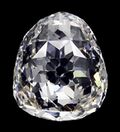
| |
| Daria-i-Noor | 182 carats (36.4 g) | light pink | In the Iranian Crown. | 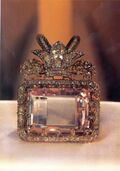
| |
| Dresden Green Diamond | 41 carats (8.2 g) | green | New Green Vault, Staatliche Kunstsammlungen Dresden. | 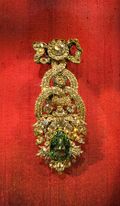
| |
| Florentine Diamond | 137.27 carats (27.5 g) | yellow | Lost | 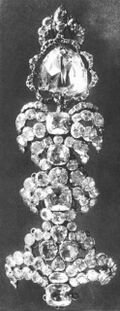
| |
| Great Mogul Diamond | 787 carats (157.4 g) | 280 carats (56 g) | colorless | Lost after Nader Shah sacked Delhi. | 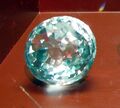
|
| Hortensia diamond | 20 carats (4.0 g) | pale orange-pink | Galerie d'Apollon, Louvre, Paris. | 
| |
| Hope Diamond | 67 carats (13.4 g) | blue | American Museum of Natural History, Washington. | 
| |
| Jacob Diamond | 184.75 carats (36.950 g) | colorless | Reserve Bank of India vaults in Mumbai. | 
| |
| Koh-i-Noor | 793 carats (158.6 g) rough |
186 carats (37.2 g) cut | colorless | (further cut for Crown Jewels); in the British Crown Jewels, London. | 120px |
| Nassak Diamond | 43.38 carats (8.676 g) cut | blue-white | Owned by American Edward J. Hand. | 
| |
| Nizam Diamond | 340 carats (68.0 g) | colorless | Not available | ||
| Noor-ul-Ain | 60 carats (12 g) | pink | National Treasury of Iran. | 
| |
| Orlov Diamond | 189.62 carats (37.9 g) | colorless | Part of the Diamond Fund at the Moscow Kremlin, Russia. | 
| |
| Pigot Diamond | 47.38 carats (9.476 g) | colorless | Sold to Muhammad Ali Pasha, Khedive of Egypt in the 1820s. Current fate unknown. | not available | |
| Princie Diamond | 34.65 carats (6.930 g) | pink | Sold to an anonymous buyer in 2013 | not available | |
| Regent Diamond | 140 carats (28 g) | colorless | Galerie d'Apollon, Louvre, Paris. | 
| |
| Sancy Diamond | 55.23 carats (11.046 g) | pale yellow | Galerie d'Apollon, Louvre, Paris. | 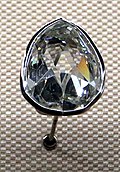
| |
| Shah Diamond | 88.7 carats (17.74 g) | colorless | Part of the Diamond Fund at the Moscow Kremlin, Russia. | 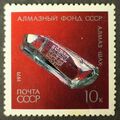
| |
| Shah Jahan Diamond | 56.7 carats (11.34 g) | colorless | Dar al Athar al Islamiyyah, Kuwait. | not available | |
| Tereshchenko diamond | 42.92 carats (8.584 g) | blue | Owned by Tereshchenko family, a business family from Ukraine | ||
| Wittelsbach-Graff Diamond | 31.06 carats (6.212 g) | blue | Owned by Hamad bin Khalifa Al Thani, former ruler of Qatar. | 
|
See also
- List of diamonds
References
- ↑ Dundek, Marijan (2009). Diamonds. nobel gems publications. pp. 11–12. ISBN 9780953788453. https://books.google.com/books?id=q8AwbhZR_pwC&pg=PA11. Retrieved 23 August 2021.
- ↑ Gomelsky, Victoria (20 March 2011). "The Market for Golconda Diamonds Has Mushroomed". The New York Times. https://www.nytimes.com/2011/03/18/fashion/18iht-acaj-diamonds-18.html. Retrieved 30 November 2016.
- ↑ Harlow, George. E (1998). The Nature of Diamonds. Cambridge University Press. pp. 73–75. ISBN 9780521629355. https://books.google.com/books?id=_WI86J88ydAC&pg=PA73. Retrieved 12 October 2021.
 |

